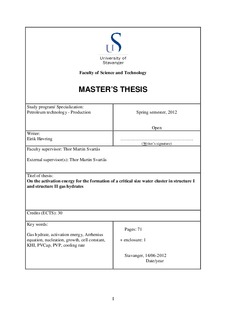| dc.contributor.author | Høvring, Eirik | |
| dc.date.accessioned | 2012-11-08T13:09:38Z | |
| dc.date.available | 2012-11-08T13:09:38Z | |
| dc.date.issued | 2012 | |
| dc.identifier.uri | http://hdl.handle.net/11250/183438 | |
| dc.description | Master's thesis in Petroleum engineering | no_NO |
| dc.description.abstract | In the present thesis, experiments have been performed in order to study the activation energy for the formation of a stable, critical size water cluster in structure I and structure II gas hydrates. This activation energy represents an energy barrier for the nucleation process forming the required particle (nuclei) size to trigger macroscopic hydrate growth.
The experiments were carried out in different laboratory high pressure cells, but of equal size and geometry. Studies were conducted on two different gases either a system consisting of pure scientific methane (99.9995 % purity) or a seven component natural gas mixture (SNG-7). The aqueous phase was either pure distilled water or distilled water added small amounts of kinetic hydrate inhibitor (KHI). Experimental conditions such as pressure, cooling rate and stirring rate were kept constant for a given experimental series, but different series could be conducted at different conditions. To determine the activation energy a minimum of three experimental temperatures were required at each experimental condition. Experiments were conducted at either 90 bars or 61 bar pressure and at cooling rates ranging from 2 °C/h to 6.75 °C/h. Fluid volumes (water + gas) were kept the same for all experiments (50 and 91.4 ml respectively). Two different KHIs were used; either PVCap with a molecular weight of 6000 Daltons or PVP with a molecular weight of 15000 Daltons. The concentration of KHI was 50 ppm based on the water phase in all experiments.
Arrhenius equation and Arrhenius plots were used to estimate the activation energy of a critical size water cluster. The radius of the critical size water cluster could be determined once the activation energy was known by assuming heterogeneous nucleation and the surface tension between hydrate and water to be 0.0276 J/m2. Heterogeneous nucleation gives smaller cluster radius than homogeneous nucleation.
In pure systems without KHI present it was concluded that the activation energy mainly was dependent on the type of fluid in the system. An increase of activation energy of approx. 27 % by increasing system pressure from 61 to 90 bar was observed, but the number of pressures examined (2) are too few to make final conclusion on effect of pressure. A slight increase of activation energy by approx. 5 % was observed at 90 bars reducing cooling rate from 6.75 °C/h to 2 °C/h, but the number of cooling rates examined (2) are too few to make final conclusion on effect of cooling.
It was concluded that the experimental cells could have different impact on the measured activation energy, as experiments conducted at similar experimental conditions in Cell #1 and Cell #3 gave not only differences in induction times, but also different activation energies. The latter was assumed due to problems of mechanical character in Cell #1, but this has not been verified by repeating the experiments in one of other, similar cells (Cell #0 or Cell #2, occupied by other students). Apparently Cell #1 required higher driving force for nucleation to occur and behaved more “stochastic” than the other cells. Cell #1 results are thus assumed less reliable than Cell #3 (SNG-7 system) and Cell #2 (pure methane) experiments.
The radius of the critical cluster size for methane sI hydrate was estimated to approx. 39 Å from experiments by this thesis work while Larson and Garside estimated the cluster size to be 32 Å from nucleation theory. Englezos et al. suggested critical size nuclei of the range 30 to 170 Å at the required activation energy for sustainable macroscopic growth. Nerheim et al. proposed approx. 100 Å. The critical size nucleus is larger than the critical size cluster at the energy barrier for the nucleation process.
In Cell #3 PVCap gave an activation energy lower than distilled water baseline. This result is logical because PVCap could act as a promoter on the nucleation process. PVCap may cause water molecules to arrange in a hydrate like structure around the Cap monomer heads. On the other hand, in Cell #1 PVCap gave activation energy higher than distilled water baseline. An explanation for the deviating Cell#1 behavior could be due to mechanical equipment problems or too few experiments performed resulting in overestimated activation energy.
PVP (Cell #3) gave activation energy higher than the distilled water baseline. The explanation for this is that PVP disturbs water structure and acts as an inhibitor on the nucleation phase. | no_NO |
| dc.language.iso | eng | no_NO |
| dc.publisher | University of Stavanger, Norway | no_NO |
| dc.relation.ispartofseries | Masteroppgave/UIS-TN-IPT/2012; | |
| dc.subject | petroleumsteknologi | no_NO |
| dc.subject | produksjonsteknologi | no_NO |
| dc.subject | gas hydrate | no_NO |
| dc.subject | activation energy | no_NO |
| dc.subject | Arrhenius equation | no_NO |
| dc.subject | nucleation | no_NO |
| dc.subject | cell constant | no_NO |
| dc.subject | PVCap | no_NO |
| dc.subject | cooling rate | no_NO |
| dc.subject | PVP | no_NO |
| dc.title | On the activation energy for the formation of a critical size water cluster in structure I and structure II gas hydrates | no_NO |
| dc.type | Master thesis | no_NO |
| dc.subject.nsi | VDP::Technology: 500::Rock and petroleum disciplines: 510::Petroleum engineering: 512 | no_NO |
